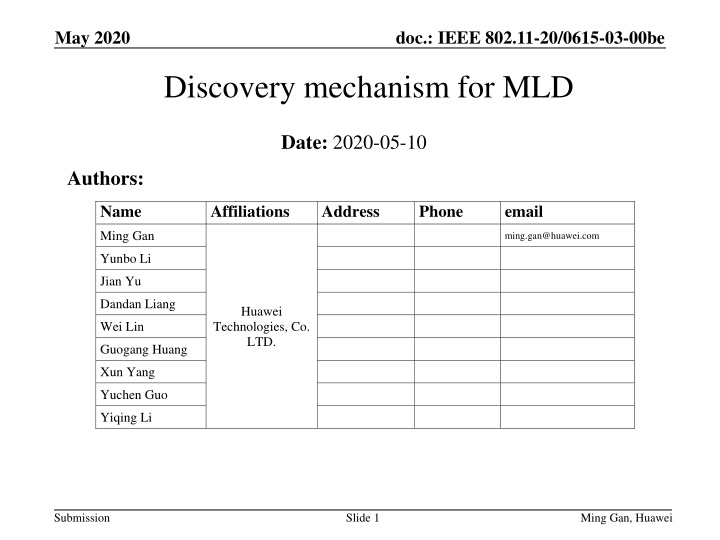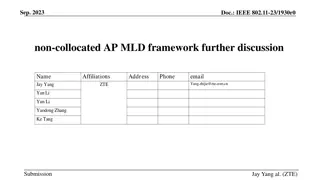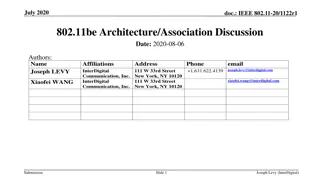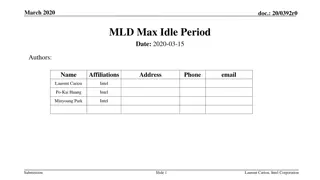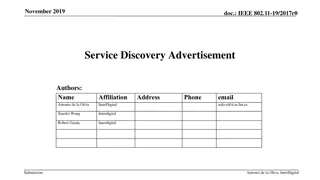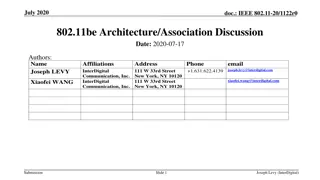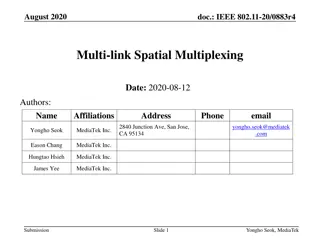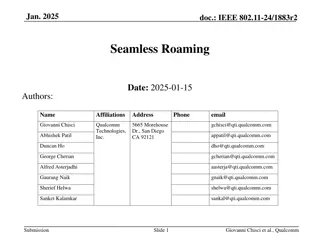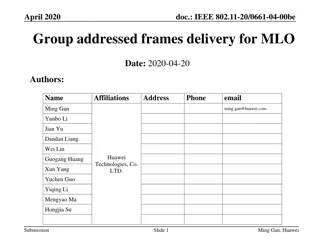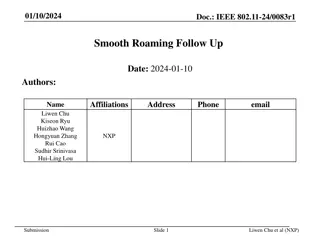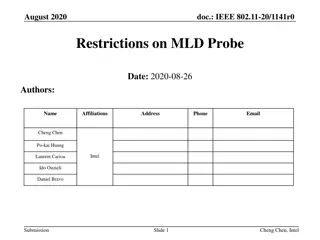IEEE 802.11-20/0615-03-00be Discovery Mechanism for MLD
The document discusses the discovery mechanism for AP multi-link devices in the context of IEEE 802.11-20/0615-03-00be standard. It covers topics such as passive and active scanning methods, AP co-location, 6GHz AP discovery, and multi-link association with AP MLD. The proposal aims to utilize the reduce neighbor report element to facilitate faster discovery processes for 6GHz APs and other APs within the same MLD.
Download Presentation

Please find below an Image/Link to download the presentation.
The content on the website is provided AS IS for your information and personal use only. It may not be sold, licensed, or shared on other websites without obtaining consent from the author.If you encounter any issues during the download, it is possible that the publisher has removed the file from their server.
You are allowed to download the files provided on this website for personal or commercial use, subject to the condition that they are used lawfully. All files are the property of their respective owners.
The content on the website is provided AS IS for your information and personal use only. It may not be sold, licensed, or shared on other websites without obtaining consent from the author.
E N D
Presentation Transcript
May 2020 doc.: IEEE 802.11-20/0615-03-00be Discovery mechanism for MLD Date: 2020-05-10 Authors: Name Affiliations Address Phone email Ming Gan ming.gan@huawei.com Yunbo Li Jian Yu Dandan Liang Huawei Wei Lin Technologies, Co. LTD. Guogang Huang Xun Yang Yuchen Guo Yiqing Li Submission Slide 1 Ming Gan, Huawei
May 2020 doc.: IEEE 802.11-20/0615-03-00be Background To discover a particular BSS/AP, a STA can do either passive scanning or active scanning To passive scan, the STA shall listen to each channel scanned for no longer than a maximum duration To actively scan, the STA shall transmit Probe Request frames containing a wildcard SSID, the desired SSID or one or more SSID List elements To speed up discovery , an AP could provide info for another AP in the same co-located set Info carried in reduce neighbor report element is an example A STA could find the info of more than one AP by just scanning one AP In this contribution, we focus on the discover mechanism for AP multi-link device (MLD). Submission Slide 2 Ming Gan, Huawei
May 2020 doc.: IEEE 802.11-20/0615-03-00be Recap 802.11ax extended the operating frequency band to 6GHz, and the AP operating on 6GHz is expected to be multi-band collocated device To avoid probe storm and make 6GHz green, a few 6GHz AP discovery mechanisms were proposed Finally, the group converged to use reduce neighbor report element to help speed up the discovery for 6GHz AP The reduce neighbor report (RNR) just carries minimum info of collocated 6GHz AP such that the beacon could not be bloated The AP operating on 2.4/5GHz shall advertise its co-located 6GHz AP through the RNR element Submission Slide 3 Ming Gan, Huawei
May 2020 doc.: IEEE 802.11-20/0615-03-00be Multi-link device The APs in a multi-link device can be regarded as co- located, but a little bit different from the excising co- located device An STA could do association with one AP to achieve multi-link association with more than one AP in its AP MLD Since Multi-link association is done just with one AP in an AP MLD, so the discovery for the AP MLD is needed Here we propose to reuse RNR carry the minimum info of the other APs in the same AP MLD as the reporting AP Submission Slide 4 Ming Gan, Huawei
May 2020 doc.: IEEE 802.11-20/0615-03-00be Multi-link device with multiple BSSID Multiple BSSID is a mandatory feature in 802.11ax, it is straight forward to implement it at EHT AP We agreed that each AP of an AP MLD is independently configured to operate as transmitted or nontransmitted BSSID of a multiple BSSID set, or not a multiple BSSID set [1] An example is shown as below, and the BSSID with x is transmitted BSSID in a multiple BSSID set We call the following structure a collocated AP MLD set MLD 1 (L1, L2, L3) MLD 3 (L1, L2) MLD 2 (L2, L3) A single STA could also be contained BSSID-1x BSSID-1y Link 1 o o Multiple BSSID set on L1 BSSID-2y o BSSID-2x o BSSID-2z Link 2 o Multiple BSSID set on L2 BSSID-3x BSSID-3y Link 3 o o Multiple BSSID set on L3 Submission Slide 5 Ming Gan, Huawei
May 2020 doc.: IEEE 802.11-20/0615-03-00be Discovery for co-located AP MLD set We propose to reuse RNR to carry the minimum info of all the other APs in the same co-located AP MLD set as the reporting AP Like Co-located subfield for 6GHz AP, we propose co-located AP MLD set in RNR element to indicate the relationship between the reported AP and the reporting AP Besides co-located AP MLD set , the relationship among the APs in the co-located AP MLD set also needs to be specified Transmitted BSSID field and Multiple BSSID field are already in the RNR element MLD-index is needed to indicate in which MLD the reported AP is, such as BSSID-Index for nontransmitted BSSID Multiple BSSID set-index is needed to indicate in which Multiple BSSID set the reported AP is Moreover, the simple index, like Link ID, for the reported AP in a MLD is needed This Link ID corresponding to the reported AP could be used for the follow up multi-link operation Slide 6 Submission Ming Gan, Huawei
May 2020 doc.: IEEE 802.11-20/0615-03-00be Discovery for co-located AP MLD set Besides the relationship among the APs in the co-located AP MLD set, it is important to avoid the repeated info with the existing advertisement, e.g., Multiple BSSID element For multiple BSSID set, the transmitted AP will broadcast Multiple BSSID element through the Beacon and Probe Response frames Multiple BSSID element carries the info of the nontransmitted BSSID If the reporting AP is transmitted BSSID, we propose that RNR element does not carry the info of any nontransmitted BSSID in the same Multiple BSSID set The corresponding MLD related info could be carried in nontransmitted BSSID profile, such as MLD-index, Link ID MLD 1 (L1, L2, L3) MLD 3 (L1, L2) BSSID-1x BSSID-1y Link 1 o o Multiple BSSID set on L1 BSSID-2y o BSSID-2x o BSSID-2z RNR MBSSID 1y 3 2y 2x 2z Link 2 o Multiple BSSID set on L2 BSSID-3 Sent by BSSID 1x Link 3 o Submission Slide 7 Ming Gan, Huawei
May 2020 doc.: IEEE 802.11-20/0615-03-00be Summary In this contribution, we propose to reuse RNR element to advertise the minimum info of the AP in the same co- located AP MLD set as the reporting AP This minimum info could help speed up the discovery for AP MLD The proposed minimum info could contain co-located AP MLD set, MLD-index, Multiple BSSID set-index and Link ID To avoid the redundant info, we propose RNR element shall not carry the info of any non-transmitted BSSID in the same Multiple BSSID set as the reporting AP Submission Slide 8 Ming Gan, Huawei
May 2020 doc.: IEEE 802.11-20/0615-03-00be References [1] 11-20-0358-03-00be-multi-bssid-operation-with-mlo Submission Slide 9 Ming Gan, Huawei
May 2020 doc.: IEEE 802.11-20/0615-03-00be SP 1 Do you agree to add MLD-index to the TBTT Information field of the RNR element, which is used to indicate the ID of the AP MLD in which the reported AP is if the reported AP in an AP MLD? MLD-Index is set to BSSID Index of a non transmitted BSSID if the reported AP is the in the same MLD as the non-transmitted BSSID and the reporting AP is the same Multiple BSSID set as the non-transmitted BSSID MLD-Index is set to zero if the reported AP is in the same MLD as the reporting AP MLD-Index of the AP MLD in which the reported AP is shall be unique in the frame sent by the reporting AP Submission Slide 10 Ming Gan, Huawei
May 2020 doc.: IEEE 802.11-20/0615-03-00be SP 2 Do you agree to carry Link ID in the TBTT Information field of the RNR element, which is used to indicate the identifier of the reported AP if the reported AP in an AP MLD? Submission Slide 11 Ming Gan, Huawei
May 2020 doc.: IEEE 802.11-20/0615-03-00be SP 3 Do you agree that a nontransmitted BSSID profile in the Multiple BSSID element shall carry the MLD related parameters, such as Link ID, if the nontransmitted BSSID is in an AP MLD? The container for Link ID is TBD Submission Slide 12 Ming Gan, Huawei
May 2020 doc.: IEEE 802.11-20/0615-03-00be SP 4 Do you agree that RNR element shall not carry the info of any non-transmitted BSSID in the same Multiple BSSID set as the reporting AP Submission Slide 13 Ming Gan, Huawei
